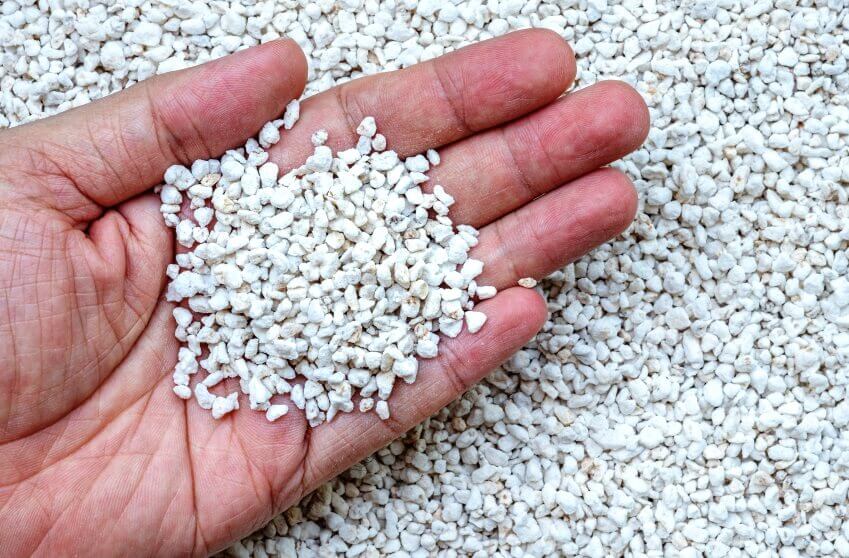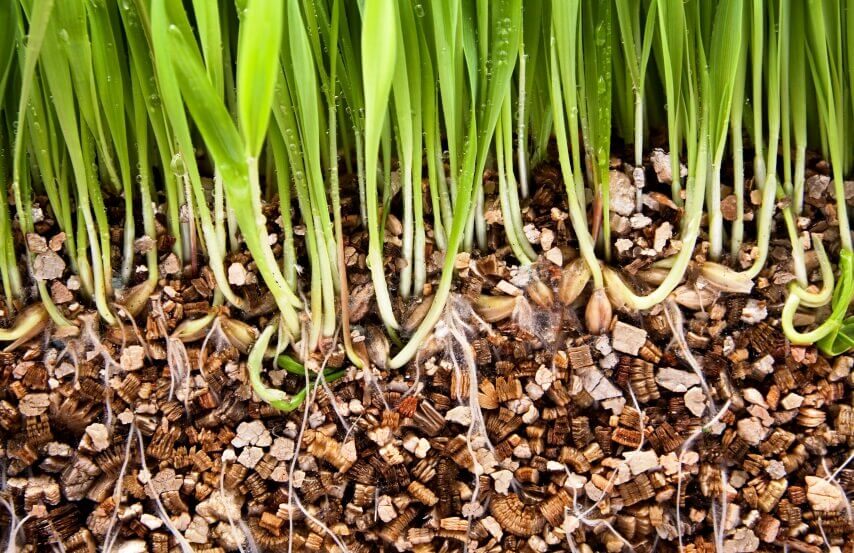There are several different inorganic substrate types that can assist your potting soil mix in improving and providing optimum drainage. What are those substrates, and how do they differ from one another? How much minerals should you mix with the soil for optimum results? This article will answer these questions and also discuss the differences between Leca, perlite, pumice, and vermiculite.
Leca vs Pumice vs Perlite vs Vermiculite
Before discussing these inorganic substrates, we need to clarify why you cannot just utilize regular soil for your plants. The reason is that a typical planting soil often has very fine grain sizes so that it can absorb too much water. This means that ordinary soil does not have good drainage and enough oxygen. In order to improve drainage and balance the water-to-oxygen ratio, you need to add some minerals to your potting mix.
Another problem with standard planting soil is that it has a lot of organic materials. Of course, this benefits your plants, but over time, when the organic materials begin to break down, your soil will become quite compact. As a result, the plant’s roots start to have issues since the soil no longer holds water in the same way it did in the past.
By incorporating inorganic material into your soil, you can actually stop compacting phenomenon from happening and improve the soil’s quality and drainage. Four different inorganic substrates, Leca, pumice, perlite, and vermiculite, can improve soil quality and drainage. But the question is: which one should you pick and what makes them different?
Leca (clay pebbles)
Leca, which stands for light-expanded clay aggregates, has been in use for a long time. Leca pebbles are tiny clay pebbles that are quite light. If you crush one, you can see that the inside is very porous, filled with a lot of air, and has a hard clay shell surrounding it.
Leca is typically placed in the bottom of the pot. This can significantly enhance drainage since all the water will pass through the soil and collect with the Leca at the bottom of the pot. Leca can also be mixed with soil, which cause the soil to drain more water and allow more air to reach the roots.
Leca
Leca in the soil mix also aids in the long-term preservation of the soil’s structure. This implies that the soil will not deteriorate or get more compact with time. However, Leca pebbles also have certain drawbacks. Leca clay pebbles dry out very rapidly; therefore, using them only helps with water drainage and oxygenation, not retaining water in the soil.
Usually, when you apply fertilizers to your soil, they come in the form of salts in your water. These salts need something to grasp onto so the roots can absorb them. Unfortunately, Leca has a very low, almost zero cation exchange capacity (CEC), which means it is not good at binding nutrients. However, it is important to note that Leca does not significantly impact the CEC of soil when your typical planting soil contains a lot of organic materials.
Although the cation ion exchange capacity of the organic material is high, the Leca’s value is relatively low. Consequently, we advise using Leca at a ratio of 1 to 5 (Leca to soil). Most of the time, it is preferable to place the larger Leca at the bottom of the pot and mix the smaller Leca with the soil. Perfect drainage can be achieved in this manner.
Perlite
Perlite is a white granular substance that is lightweight. It is formed of expanded volcanic glass that has been heated to 1000°C till it “pops” (like popcorn) to many times its original size. It appears and feels like tiny pieces of polystyrene. It is durable, clean, lightweight, and simple to use. It is neither acidic nor alkaline [1].
Note: Perlite has too much dust, so it is recommended that you handle it a little bit wet. Although the dust from perlite will not harm you, since it is made of glass fiber, it is best to avoid breathing it in. To avoid this, it is better to rinse your hands after handling perlite.
Perlite is highly porous, and due to its expanded nature, it can help with drainage. While perlite has a much higher water absorption capacity than leca, it only absorbs a small portion of the water added to your soil (Perlite water absorption capacity =20% [2]).
Perlite
As noted previously, ordinary planting soil often absorbs a lot of water and pushes out all of the oxygen. You need to maintain a balance between water and oxygen in the soil to keep the plant happy. Adding perlites to your soil can improve drainage, allowing more water to escape from the pot and giving your roots more oxygen.
Now the question is: how much perlite should you mix with your planting soil?
Since that perlite is quite lightweight, it is advised to add 20 to 30 percent of perlite to your soil mixture (in volume rather than weight). Like Leca, perlite dries up very quickly, so you should also take that into account.
Generally speaking, Leca and perlite are both excellent choices for plants that need to dry out quickly between waterings. Perlite has a very low cation exchange capacity (3 meq/100g [3]), which is also something you need to be aware of when adding it to your soil.
Pumice
Pumice is a light volcanic material that is a little bit heavier than perlite and Leca. Pumice is the lightest material thrown out of a volcano when it erupts, so it is not man-made. In fact, pumice is a natural mineral that is created inside volcanoes.
Pumice is very porous and has many cavities inside of it. The main benefit of utilizing pumice is that it can increase water holding capacity while promoting good drainage (Pumice water absorption capacity =30% [5]).
Pumice has larger grain sizes, so when you add it, the soil will drain a little bit more, allowing you to get rid of the extra salt and water. Plants love to be wet, so the growth substrate should offer adequate water for plants, but not too much. Pumice is an excellent pick for such conditions.
Pumice
Pumice helps aerate the soil while also assisting in the absorption and gradual release of water. As a result, to get the ideal good drainage while maintaining the proper balance of water and oxygen, pumice is added to the soil along with water and oxygen.
Pumice is capable of preserving water. Every single pumice stone has numerous minuscule holes that function as tiny sponges to collect the nutrient-rich water and hold it until the soil needs to be hydrated. By incorporating pumice into your soil, you can increase the availability of food and water for root uptake while also bringing oxygen to the root zone, allowing carbon dioxide to exit, and promoting air circulation[6].
Pumice is heavier than its top rival, perlite. That is why it can stay in your soil mix rather than float to the top of your containers and blow away. Additionally, unlike perlite or Leca, pumice does not dry out as rapidly.
As previously noted, pumice retains moisture slightly longer, which can be advantageous but potentially disadvantageous depending on the sort of plant you are potting. Generally, The recommended amount to utilize pumice in your soil is 20 to 30 percent of the soil mix volume.
Pumice also has the advantage of allowing roots to move inside the stones. Fine roots can cling to each pumice stone to obtain the ideal oxygen and water levels. However, it is worth mentioning that pumice has a low cation exchange capacity (5-6 meq per 100g [5]), which is one of its disadvantages.
Some people like to cultivate plants in pumice. However, if you want to grow plants in pumice, you need to add something that can hold and bind nutrients. Typically, when you want to grow in pure pumice, you should add some clay to it to reach an ideal cation exchange capacity.
The fact that pumice can be reused is a plus. Leca and perlite are harder to reuse as you may throw them away when you are repotting, but pumice may be used often by just rinsing.
Vermiculite
Vermiculite is a type of clay that has also been heated by humans, like perlite and Leca, and it is also quite lightweight. That mineral pops when heated, almost like popcorn, yet it differs structurally from perlite. Vermiculite has a cylindrical shape, which is more rounded, like a popcorn ball. Because of this, vermiculite substrate can absorb three to four times its weight in water.
Combining vermiculite with your regular planting soil somewhat improves drainage as your soil’s grain sizes increase. You must use vermiculite for a plant that requires a lot of water since it absorbs so much water.
Vermiculite
The recommended amount to utilize vermiculite in your soil is 10 to 20 percent of the soil mix volume. Vermiculite in this quantity is typically sufficient because adding more would result in the soil retaining an excessive amount of water, which would be detrimental to most plants. But if you have a water-loving plant, like the peace lily, which prefers to stay moist most of the time, vermiculite is a fantastic choice. You can use vermiculite to make an ideal peace lily soil mix.
Vermiculite also boasts a respectable level of cation exchange capability (100-150 meq per 100g [2]), which is a plus. Due to the fact that it is a type of clay, it retains a lot of nutrients; therefore, by adding it to your soil, you are increasing the ways in which nutrients can be bound.
Last but not least, vermiculite’s exceptional ability to hold water makes it a popular choice as a stand-alone substrate for seedlings and cuttings. As a result, you can have cuttings take root in pure vermiculite and then replant them in a soil mix containing vermiculite. In this way, you can make the transition easier and less stressful for the rooted cuttings.
Conclusion
To sum up, the sort of mineral substrate you should use for your tropical indoor plants depends entirely on the kind of plant you have. Look at your plant needs. If it wants fully dry out between waterings, you should use Leca, perlite, or possibly pumice.
Conversely, if you have a plant that requires a lot of water and perhaps should not ever dry out, you should use vermiculite or pumice, which both holds a lot of water while also adding oxygen to get the ideal balance.














